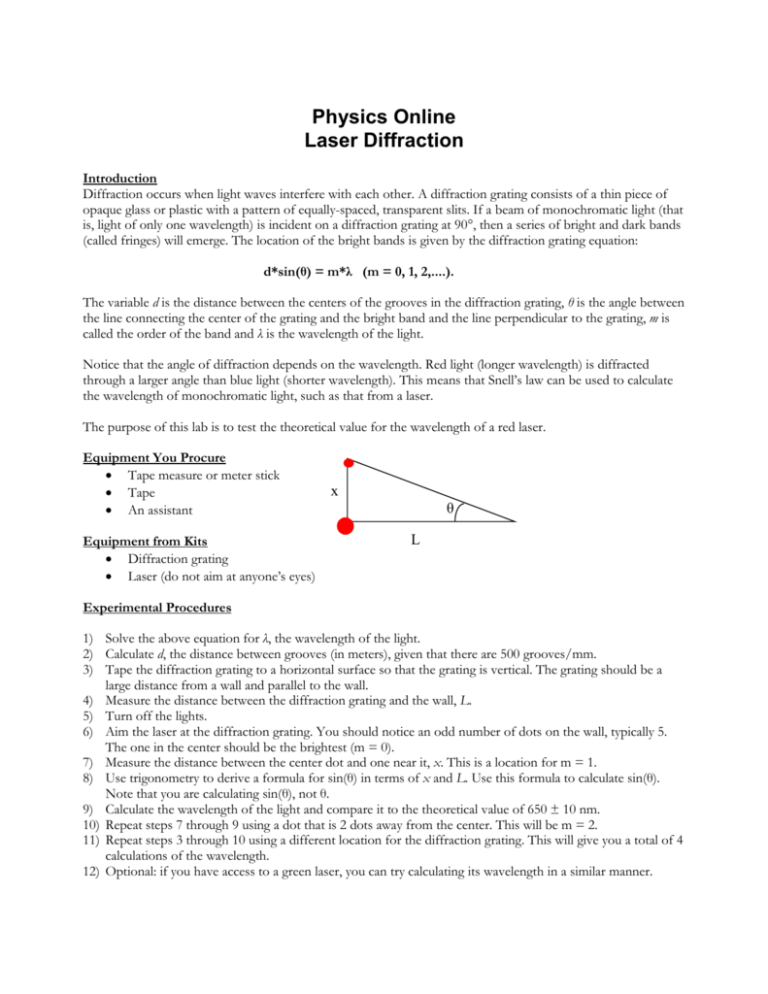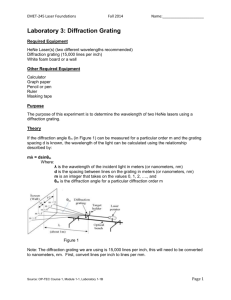Laser Diffraction - faculty at Chemeketa
advertisement

Physics Online Laser Diffraction Introduction Diffraction occurs when light waves interfere with each other. A diffraction grating consists of a thin piece of opaque glass or plastic with a pattern of equally-spaced, transparent slits. If a beam of monochromatic light (that is, light of only one wavelength) is incident on a diffraction grating at 90°, then a series of bright and dark bands (called fringes) will emerge. The location of the bright bands is given by the diffraction grating equation: d*sin(θ) = m*λ (m = 0, 1, 2,....). The variable d is the distance between the centers of the grooves in the diffraction grating, θ is the angle between the line connecting the center of the grating and the bright band and the line perpendicular to the grating, m is called the order of the band and λ is the wavelength of the light. Notice that the angle of diffraction depends on the wavelength. Red light (longer wavelength) is diffracted through a larger angle than blue light (shorter wavelength). This means that Snell’s law can be used to calculate the wavelength of monochromatic light, such as that from a laser. The purpose of this lab is to test the theoretical value for the wavelength of a red laser. Equipment You Procure Tape measure or meter stick Tape An assistant Equipment from Kits Diffraction grating Laser (do not aim at anyone’s eyes) x θ L Experimental Procedures 1) Solve the above equation for λ, the wavelength of the light. 2) Calculate d, the distance between grooves (in meters), given that there are 500 grooves/mm. 3) Tape the diffraction grating to a horizontal surface so that the grating is vertical. The grating should be a large distance from a wall and parallel to the wall. 4) Measure the distance between the diffraction grating and the wall, L. 5) Turn off the lights. 6) Aim the laser at the diffraction grating. You should notice an odd number of dots on the wall, typically 5. The one in the center should be the brightest (m = 0). 7) Measure the distance between the center dot and one near it, x. This is a location for m = 1. 8) Use trigonometry to derive a formula for sin(θ) in terms of x and L. Use this formula to calculate sin(θ). Note that you are calculating sin(θ), not θ. 9) Calculate the wavelength of the light and compare it to the theoretical value of 650 ± 10 nm. 10) Repeat steps 7 through 9 using a dot that is 2 dots away from the center. This will be m = 2. 11) Repeat steps 3 through 10 using a different location for the diffraction grating. This will give you a total of 4 calculations of the wavelength. 12) Optional: if you have access to a green laser, you can try calculating its wavelength in a similar manner.









